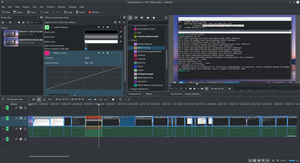Kdenlive
Kdenlive (/ˌkeɪdɛnˈlaɪv/;[3][4] acronym for KDE Non-Linear Video Editor[5]) is a free and open-source video editing software based on the MLT Framework, KDE and Qt. The project was started by Jason Wood in 2002, and is now maintained by a small team of developers.[6]
 | |
 Kdenlive 20.04.1 | |
| Developer(s) | KDE |
|---|---|
| Stable release | 20.04.1[1]
/ 16 May 2020 |
| Repository | |
| Written in | C++ (Qt, KF5)[2] |
| Operating system | Linux Microsoft Windows macOS (source code only) |
| Type | Video editing software |
| License | GNU GPLv2+ |
| Website | www |
With the release of Kdenlive 15.04.0 it became part of the official KDE project.[7]
Kdenlive packages are freely available for Linux, FreeBSD, and Microsoft Windows, and the source code is available under the terms of GNU General Public License version 2 or any later version.
Features


KDE's Kdenlive makes use of MLT, Frei0r effects, SoX and LADSPA libraries. Kdenlive supports all of the formats supported by FFmpeg or libav (such as QuickTime, AVI, WMV, MPEG, and Flash Video, among others), and also supports 4:3 and 16:9 aspect ratios for both PAL, NTSC and various HD standards, including HDV and AVCHD. Video can also be exported to DV devices, or written to a DVD with chapters and a simple menu.[8][9][10]
- Kdenlive has multi-track editing with a timeline and supports an unlimited number of video and audio tracks.
- A built-in title editor and tools to create, move, crop and delete video clips, audio clips, text clips and image clips.
- Ability to add custom effects and transitions.
- A wide range of effects and transitions. Audio signal processing capabilities include normalization, phase and pitch shifting, limiting, volume adjustment, reverb and equalization filters as well as others. Visual effects include options for masking, blue-screen, distortions, rotations, colour tools, blurring, obscuring and others.
- Configurable keyboard shortcuts and interface layouts.
- Rendering is done using a separate non-blocking process so it can be stopped, paused and restarted.
- Kdenlive also provides a script called the Kdenlive Builder Wizard (KBW) that compiles the latest developer version of the software and its main dependencies from source, to allow users to try to test new features and report problems on the bug tracker.[11]
History
The project was initially started by Jason Wood in 2002. The development of Kdenlive moved on from the K Desktop Environment 3 version (which wasn't originally made for MLT) to KDE Platform 4, with an almost complete rewrite. This was completed with Kdenlive 0.7, released on 12 November 2008.[12] Kdenlive 0.9.10 released on 1 October 2014 was the last KDE 4 release.
Kdenlive started to plan a move into the KDE project and its infrastructure in 2014.[13] Port to KDE Frameworks 5 was finished with the release of 2015.04.0 as part of KDE Applications 5.[14] The move to KDE is ongoing.[15]
In early 2017 the development team started working on a refactoring of the program, and by June 2017 a first preview was available.[16] By December 2017 the refactoring became the main focus of the development team with the release of the first usable preview.[17] Release of the refactoring version was originally planned for August 2018 in the KDE 18.08 Applications release.[18] The refactored version of Kdenlive was released on 22 April 2019 in the KDE 19.04 Applications release.[19]
References
- Mardelle, Jean-Baptiste. "Kdenlive 20.04.1 released". Retrieved 17 May 2020.
- "The Kdenlive Open Source Project on Open Hub". Black Duck Software. Retrieved 1 August 2018.
- Smart, Christopher (9 July 2009). "Kdenlive: A Video Editor in the Spotlight". Linux Magazine. Archived from the original on 1 August 2018. Retrieved 1 August 2018.
- Sawyer, Dan (1 March 2008). "Multitrack Video Editor Roundup". Linux Journal. Archived from the original on 1 August 2018. Retrieved 1 August 2018.
- "About". kdenlive.org. Retrieved 7 March 2020.
- "Kdenlive / Libre Video Editor". kdenlive.org. Archived from the original on 26 August 2018. Retrieved 1 August 2018.
- "KDE Applications 15.04 Adds KDE Telepathy Chat and Kdenlive Video Editing". KDE.org. 15 April 2015. Retrieved 1 August 2018.
- Wikibooks:Kdenlive/What Kdenlive is
- "KDE Commit-Digest - 12th October 2008". KDE.org. 12 October 2008. Archived from the original on 10 November 2013. Retrieved 1 August 2018.
- "Features". kdenlive.org. Retrieved 1 August 2018.
- "Kdenlive Builder Wizard". Kde-apps.org. Archived from the original on 7 September 2015. Retrieved 7 October 2013.
- "Kdenlive 0.7 Released". Archived from the original on 2 April 2015.
- "Granjow's blog - Randa meeting 2014". Archived from the original on 17 April 2015.
- "Kdenlive to be released with KDE Applications 15.04". Archived from the original on 21 March 2015.
- "Kdenlive 15.04.0 released". Archived from the original on 17 April 2015.
- "Kdenlive – refactoring preview and news". kdenlive.org. 20 June 2017. Retrieved 1 August 2018.
- "Kdenlive 17.12.0 released". kdenlive.org. 15 December 2017. Retrieved 1 August 2018.
- Mardelle, Jean-Baptiste (4 July 2018). "Kdenlive: test the future | Kdenlive". kdenlive.org. Retrieved 14 August 2018.
- "Kdenlive 19.04 released". kdenlive.org. 22 April 2019. Retrieved 8 December 2019.

